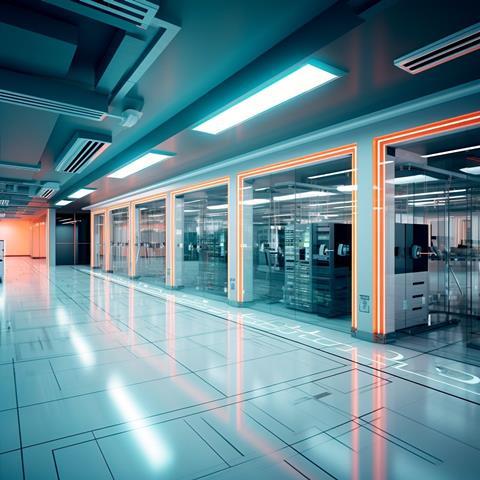Demand for data, and a surge in AI, means changing needs and rapid growth for the data centre sector. Is the UK set up to take full advantage, asks Scott Smyth Founder & CEO of Soben
Google’s announcement earlier this month that it would be investing $1bn (£0.79bn) in a new data centre in Hertfordshire is more good news for the UK.
It followed on from a November government press release trumpeting Microsoft’s plan to invest £2.5bn over the next three years to build artificial intelligence (AI) infrastructure here.

AI is super-charging demand for new data centre space around the world, as our annual Data Centre Trends report shows. However, even before this surge in space requirements, the sector was facing a raft of challenges.
Power is perhaps the biggest constraint on development in data centre hotspots here in the UK and overseas.
But there are other hurdles too: shortages of contractors and individuals with the right competencies; limited supply of land in some markets; some lead times on equipment starting to creep back up again.
All this is set against a backdrop of energy transition, with investors and legislators demanding that data centre operators reduce their carbon footprints.
We are already seeing adjustments in response to these constraints.
Procurement strategies are changing, there are new entrants to the market, more operators are looking for renewable power and new locations are under scrutiny or development.

But if the UK is to lead the transition to a digital economy, as the government has suggested, we need a much more strategic approach to planning and power.
Local authorities must understand the importance of data centres in helping to fuel growth in every sector.
And we need faster action and investment in the power grid, transmission, and distribution network, which just isn’t fit for purpose as things stand.
Heading north
Traditionally, the UK’s data centres have been concentrated in west London, adjacent to fibre optic cables that run from the M4 corridor and on across the Atlantic to the US. Some are a little further out in Slough.
But power is constrained. Some 18 months ago, housing developers reported that their planning applications were being turned down because data centres were sucking up the capacity. Today, data centres operators applying for more power are being told they could face a five-to-seven year wait.

Hardly surprising, then, that developers and operators are looking to move north. Microsoft has said that it will be investing some of its £2.5bn around Cardiff and possibly in the Nort-west. And it has already submitted planning permission for a 1m sq ft (92,900 sq m) data centre in Newport.
At Soben, we think data centre developers should be looking even further north to our home ground of Scotland.
Aside from its cooler climate and plentiful land supply Scotland boasts renewable energy from onshore and offshore wind, hydro and solar power, producing 97% of its gross electricity consumption in 2022.
Host in Scotland, which represents the data centre and subsea sectors, has identified 20 promising data centre sites close to renewable power sources.
AI drives change
AI will change almost every sector. Which means that our need for data processing and storage is set to explode. ChatGPT is perhaps an extreme, but illustrative case: 0 to 180.5 million users in 12 months.
The headache for the data centre sector over the past 12 months has been how to accommodate that growth. Because the pace of change is so fast, there are many uncertainties over exactly what will be needed.
And there is more work to do on data centre technologies such as liquid cooling which will be needed to deal with the heat kicked out by the graphics processing units (GPUs) needed for AI.
Everyone has been watching the major players intently. And now we are seeing hyperscalers such as Microsoft and Meta making their first moves.

Flexibility is definitely the order of the day, investing more upfront in new facilities to accommodate change later.
There’s no one answer to what will be needed. While some AI data centres will need to be close to the cities and industrial hubs they serve, those used for training or machine learning can be located more remotely, in Scotland, for example.
For these centres, space and access to renewable energy are more important than low latency – or time to send data – and resilience. A cooler climate is also a bonus, to reduce cooling energy and cost.
New entrants
With all the current and promised activity, and a finite number of contractors already working in the sector, it’s hardly surprising that new players are throwing their hats into the ring.
For instance, contractors Glencar and Strabag UK both recently announced new teams that would be pursuing data centre contracts – a new area for both players.
Shortages of resource in every part of the supply chain are driving a shift to 21st century construction. As our Trends report details, BIM is now a must for data centre projects in the main US and European hubs.
Meanwhile, offsite is no longer an expensive dream, rather a necessity that mitigates shortages of skilled mechanical and electrical tradespeople on site.
While these transitions to digital tools and renewable energy are positive changes, we need more government support to prevent a log jam of projects in the near future. Data centres are the oil of our emerging digital economy; without enough, things will grind to a halt.
The government is certainly making the right noises, with its fanfare over the Microsoft AI investment and an enthusiastic response to Google’s news on X from none other than Rishi Sunak.
But now we need action. Unless our power distribution grids are upgraded so that they can serve data centres and other transitioning industries and connect to renewable power sources, UK plc will effectively be hitting the brakes when it should be accelerating on the journey to net zero and economic growth.
Find out more about the challenges and opportunities facing the global data centre market in Soben’s second annual Data Centre Trends report: www.sobencc.com/dctrends2024



























